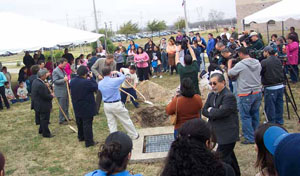Good times are being celebrated this spring during the twentieth Anniversary events that showcase the past successes of Palo Alto College while pledging continued support to future generations.
The first event to kick off the spring celebration was the Presidential Scholarship Program and burial of a time capsule on Feb. 24, 2006. The entire third grade class of Palo Alto Elementary was promised full scholarships to Palo Alto College when they graduate from high school. This commitment is a continuation of a promise that was made to area second graders during Palo Alto’s tenth Anniversary Celebration. Sixty-seven students were given the opportunity to attend Palo Alto, and 36 of those students enrolled here in the Fall of 2005.
Students from
Palo Alto Elementary and visiting dignitaries bury a time capsule to celebrate
the college’s 20th birthday.
Photo by Jewelette Botello
“Palo Alto College has contributed to a complete change in the way education is viewed in this city, and they are following up on the promise of continuing to share the importance of education,” said David Hope, who has been an instructor in the Math Department since the college’s inception in 1986.
During the 2006 PACFest on April 27, an official Fiesta event, 20 trees will be planted to commemorate Palo Alto’s continued growth. Headlining the entertainment will be Las 3 Divas, as well as the Electric Cowboys, Mariachi Palomino, Conjunto Palo Alto and the Palo Alto College Jazz Ensemble.
“Trees start out very tiny and grow to be very large and are around for a long time, and we started out very small and are expanding our branches as we grow,” said Karen Marcotte, Professor of Humanities and founding faculty member, who was hired in August of 1985.
In February of 1983, the Alamo Community College District Board of Trustees established Palo Alto College, which was chartered by the Texas Legislature the following month as a two-year public institution. Classes began in September 1985 with 231 students enrolled.
“We lacked everything but students,” said Marcotte, who taught at various locations like the police station, local high schools and the Southwest Center in East Kelly Field during the college’s first two years.
“I felt there were signs of a vision and got caught up with being part of it,” said Hope. This vision seems to be part of what drew in many of the founding faculty members.
“With PAC came the discussion that maybe we should have education available to San Antonio, and turn blue collar laborers into more active members of society. If you talked to people at that time, there was a mindset present that did not see higher education as a necessity, which caused lower expectations to overpower many of the voices that sought change,” said Hope.
Before a single brick was laid, the mind-sets of the politicians who represented the South Side at that time was negative, said Virginia Meyers, one of the leaders of the grassroots organization Communities Organized for Public Service (COPS). This organization voiced the concerns of the predominantly Hispanic community who, Meyerssaid, cried out for an equal opportunity to have access to educational resources.
Anger rose in the voice of Meyers when she recounted what the ACCD Board members of the time thought: “There is no need for education on the South Side; people over there will not go to college.”
COPS’ response: “You build that college, and we will get the people there.”
Palo Alto now enrolls more than 8,000 students, and 10,000 students are expected by 2010.
“Like those trees, we will be changing again and always growing,” said Marcotte.
